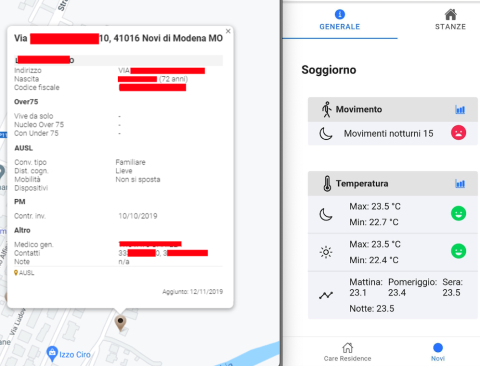Digital in Support of Fragility - Unione delle Terre d Argine
Unione delle Terre d Argine (Italy)
In May 2012 a strong earthquake struck the Municipalities of the Union of Terre d'Argine. On that occasion, one of the first activities was to check the health status of elderly and needy people and then evacuate them to safe facilities where they could receive the necessary care.
It was immediately clear that the operation was complex: the elderly people were numerous and sometimes there was no information about their residence, their pathologies, and their health needs, whether they lived alone or had someone to support them. Sometimes this information was available, but disaggregated and held by different and difficult-to-consult subjects.
Therefore, there was a need to create an application that would collect this information to allow civil defense and red cross to easily identify and help people in difficulty during emergency situations such as earthquakes or floods.
In addition to mapping needs to better manage emergency situations, later the application was enriched with data from IoT sensors: battery-powered sensors (that do not require any wiring) were placed inside structures that host fragile but independent elderly people, capable of providing data on the person's movement (or lack of it), environmental data such as temperature, humidity, and brightness at predetermined intervals.
This data is processed by a dashboard capable of providing a significant overview of behaviors and allows to verify whether the elderly lead a regular life, moving during the day and resting at night in a comfortable environment.
Any detection of lack of movement during the day or vice versa, frequent movements or prolonged levels of light during nighttime hours, can be anomalous conditions and as such reported to the responsible operators and doctors so that they can assess the importance and any intervention.
- the service uses and aggregates data already held by Public Administration, without asking citizens again;
- the application comes from a multi-organizational collaboration, as it uses and integrates data from different public organizations;
- the application is secure, clear, and easy to use;
- the application reduces administrative burden as it simplifies public administration activities (both in emergency situations and in ordinary activities) and offers citizens a personalized, proactive, and preventive service;
- all stakeholders were involved in the development of the application: healthcare workers, civil protection personnel, and senior citizens;
- data is only used if citizens expressly consent. Data is only viewed by healthcare personnel and civil protection and only for the purposes provided by the application.
- The developed software is easily reusable by other public administrations since it has been designed to be used by different subjects: each user only sees the data of their interest.
Dashboards powered by IoT sensor data allow for easy monitoring of the health status of elderly people, intervening only when necessary. This monitoring allows the elderly to delay the loss of self-sufficiency.
During emergency situations, the digital service facilitates support and rescue operations for those in need:
- during the Covid-19 pandemic, 4000 individuals in need were contacted by phone to check on their health. Since schools were closed during that time, kindergarten teachers were asked to make the phone calls;
- in December 2020, the Secchia river broke its banks and was at risk of flooding. Through the application, social services first identified, then contacted and monitored vulnerable individuals residing near the river stretch at risk, who were unable to move independently due to health reasons. This allowed the Civil Protection to intervene in a timely manner by providing the necessary support with suitable and specific tools to the patients' homes, and, where necessary, to evacuate the users at the exact geolocated point.
The application developed to better manage emergency situations was designed with the cooperation of operators from civil defense (how to enter and view data from the Geographic information system, the registry office, the health service, social services).
Together with the healthcare workers, co-design sessions were carried out where we determined:
- what data to measure and what sensors to use
- how to identify dangerous or uncomfortable situations, that is, how to use the collected data to create a useful dashboard for our purposes.
Together with the operators, a usability test was conducted to ensure that the dashboards were simple, clear, and easily readable.
In this phase, further requests were collected from the operators, which led to modifications of the dashboard. The operators were also involved in training activities and for testing and testing the platform.
Then we met with fragile citizens. Fragile citizens are independent people (living alone), but in need of help and monitoring. Together with them, we shared the project objectives, the choice of sensors to be used and the data to be collected, and we asked for permission to process the data (no one refused).
